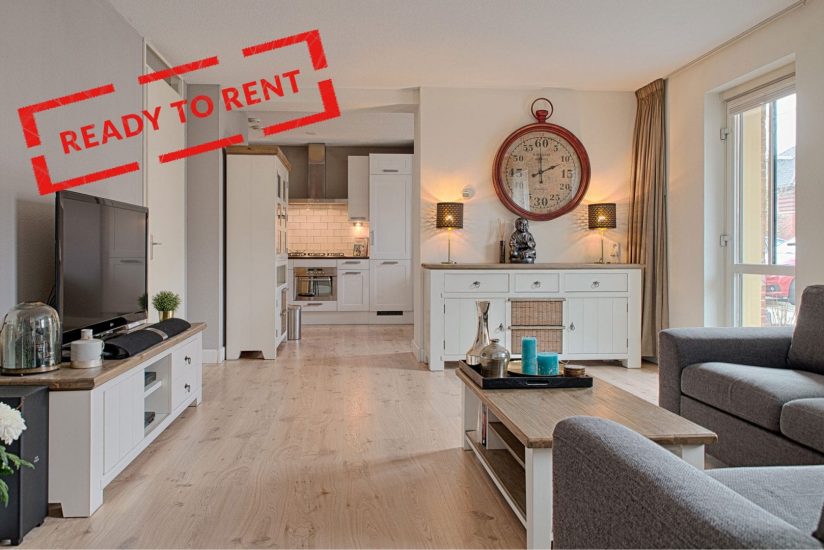As an Interhouse verhuurmakelaars franchisee, I am part of a group of dedicated entrepreneurs who specialise in letting properties. Among other things, we often share experiences and exchange contacts. As a group we let thousands of residential properties a year and have already celebrated our 25th anniversary. This wealth of experience means that we know exactly what it takes to rent out a property properly. By properly I mean letting it quickly to a high-quality tenant at the right rent.
The advantages to be gained from thorough preparations and making the right decisions will continue to be felt during the tenancy agreement. Thorough preparations are crucial prior to letting a property. I talk to (future) landlords every day and they often ask what they need to do to make their residential property ready for rental. I enjoy applying my expertise to individual cases. Each property requires a different approach and we often come up with ideas and tips that landlords would never think of themselves.
I decided to list the 10 main tips to share with those of you who are interested.
- Make sure your home is in a good state of repair.
It seems so obvious, but every property needs to be scrutinised carefully. Check the condition of items such as doors and windows, central heating (maintenance), kitchen cupboards, parquet floors, light bulbs, curtain rails etc. Starting off in a good state of repair prevents a great deal of hassle during the tenancy agreement. - Make sure your home also looks good.
Cast a critical eye over paintwork and wallpaper. A tidy tenant is looking for a tidy home. A home that is not in the best condition is more likely to attract a tenant who doesn’t care about such things. Such tenants are often more lax about other things too. Experience teaches us that a well-maintained property often stays in a much better condition. - Invest in a one-off deep, professional clean.
If you do this once and can present an invoice for it, we will demand that the tenant does the same at the end of the tenancy agreement. We explicitly include this in the tenancy agreement. The tenant gets a property that has been cleaned professionally and has to do the same on vacating it. A fair deal that avoids discussions on whether or not the property is indeed clean. - Provide the tenant with a proper master key plan comprising at least two complete sets of keys.
Match the number of sets to the type of property and composition of the tenant (single, couple or family). Make sure there are sound locks and keys, preferably one key for all the doors. This may entail a one-off investment but certified locks ensure that it is sorted for many years to come. Don’t forget to make sets for yourself and the estate agent/manager as well as those for the tenant. - Compile a comprehensive information file for the tenant.
Instructions for use of all (kitchen) appliances in the property, information from the municipality, the refuse collection schedule, some local information, perhaps some handy tips on the property etc. These are all very useful to the tenant. This file belongs to the property and can be used by each successive tenant. - Make any outside areas as low maintenance as possible.
This of course depends on the type of property, but make sure it is relatively easy for the tenant to keep any outside areas in good condition. If the property has a sizeable garden that requires regular upkeep, try to draw up a maintenance plan, where applicable with the assistance of a (specific) gardener. Garden maintenance by tenants is often an issue on termination of a tenancy agreement. It’s best to do everything you can to avoid problems later as it can be very expensive to restore a garden that has been neglected. - Inform your neighbours and any Residents’ Association that you are letting your property.
This is also part of preparing your property for rental. It prevents queries from or disagreements with these parties and will also mean that your tenant is made to feel more welcome. Almost all Residents’ Associations require notification on a property being let, as well as signature of a user declaration by the tenant. - You need to do this if you are letting your property semi-furnished.
Semi-furnished means that the property includes floor, wall and window coverings and light fittings. It is important that everything is in good condition. Make sure that the curtains are clean, that all the lights work, that walls are properly finished and free from holes and that floors are in good condition. If possible, avoid having carpets in the property. Few tenants like properties fitted with carpet. Hard floors are generally preferred for reasons of hygiene and potential allergies. - You need to do this if you are letting the property fully-furnished.
Fully-furnished means that in addition to the furnishings listed under point 8 the property also contains all the furniture required to live in it comfortably. The basic criterion is that everything is provided for the tenant, who then really only needs to bring personal items. In addition to furniture, the kitchen needs to be fully equipped, there must be bed linen and towels, one or more television and audio equipment, a vacuum cleaner, an ironing board and iron etc. If there are outside areas there should also be garden furniture, and if applicable gardening tools etc. Also think about decorative items such as pictures, plants etc. All the inventory needs to be in good condition and is tax-deductible. - Arrange formalities with the mortgage lender, insurer, municipality, subscriptions etc.
A property is really only completely ready for rental when you can sign a tenancy agreement with peace of mind. This means that the parties towards which you have obligations also need to agree to it being let. If your property is mortgaged, you cannot simply let the collateral on your loan without the consent of the mortgage lender. The insurer also needs to be notified that the insured property is to be rented out; different terms and conditions usually apply in such cases. If you are moving to a different address, you need to register your new address with the municipality and you will then automatically be deregistered from the address that you are letting. Don’t forget to cancel your subscriptions to services such as the internet, cable television, window cleaning, refuse container cleaning etc. The estate agent will take care of meter readings and related procedures on transfer of the property.My many years of experience in the business have convinced me that selection of the right rental agent provides crucial added value. There are many other important issues on top of advice on preparing your property to be let. Issues that ensure that the strategy, approach, letting process and ultimately the entire duration of the tenancy agreement go as planned. This demands knowledge and experience. Pinpointing the right target group for the property, for example, forms the basis for the rest of the procedure. Yet the target group in turn depends on the type of property and location, as well as the landlord’s situation. That specific target group then needs to be reached and candidates thoroughly screened before you can conclude a legally-correct customised tenancy agreement. After all, you want what has been agreed to be legally water-tight. Once a tenancy agreement has commenced, it is important to manage it properly and accurately; this keeps the tenant satisfied and your property in good condition.
I hope you will find my tips useful. I – or one of my colleagues at our other offices – am of course available to answer any questions you may have in person. I look forward to viewing the property you wish to let, to meeting you in person and demonstrating the added value of the services we provide; all completely free of any obligation.


